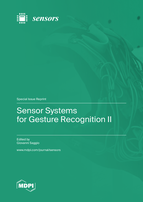Sensor Systems for Gesture Recognition II
A special issue of Sensors (ISSN 1424-8220). This special issue belongs to the section "Physical Sensors".
Deadline for manuscript submissions: closed (28 February 2023) | Viewed by 32137
Special Issue Editor
Interests: wearable sensors; brain–computer interface; motion tracking; gait analysis; sensory glove; biotechnologies
Special Issues, Collections and Topics in MDPI journals
Special Issue Information
Dear Colleagues,
Gesture recognition (GR) aims to interpret human gestures by means of mathematical algorithms. Its achievement will have widespread applications in a number of different fields, with impacts that can help or meaningfully improve our quality of life.
In the real world, GR can interpret communication meanings at a distance or can “translate” “sign language” into written sentences or as a synthetized voice. In a virtual reality (VR) and augmented reality (AR) world, GR can allow navigation and interaction, as occurs, for instance, with the user interface (UI) of a smart TV controlled by hand gestures.
The possible applications are countless, and we can mention just a few. In the health field, GR makes it possible to augment the motion capabilities of disabled people or to support surgeons in surgical settings. In gaming, GR frees gamers from input devices such as keyboards, mouses, and joysticks. In the automotive industry, GR allows drivers to control car appliances (see BMW 7 Series). In cinematography, GR is used to computer-generate effects or creatures. In everyday life, GR is a means to interact with smartphone apps (e.g., uSens, Inc.; Gestigon GmbH). In human–robot interactions, GR keeps the operator in safe conditions, while their gestures become the remote commands for tele-operating a robot. GR also enables music creation, converting human movements into sounds.
GR is achieved through (1) data acquisition, (2) pattern identification, and (3) interpretation (each of these phases can consist of different stages).
Data can be acquired by means of sensor systems based on different measurement principles, such as mechanical, magnetic, optic, acoustic, inertial principles, or hybrid sensors. Within this frame, optical technologies are historically the most explored ones (since 1870, when animal movements were analyzed via image sequences) and represent the current state of the art. However, optical technologies are expensive and require a dedicated room and skilled personnel. Therefore, non-optical technologies, in particular those based on wearable sensors, are increasingly gaining importance.
In order to obtain GR, different methods can be adopted for data segmentation, feature extraction, and classification. These methods highly depend on the type of data (according to the adopted type of sensor system) and the type of gestures to be recognized.
The supervised on unsupervised) recognition of patterns in data (i.e., regularities, arrangements, characteristics) can be approached by machine learning or heuristics, and can be linked to artificial intelligence (AI).
In sum, sensor systems for gesture recognition deal with an ensemble of topics that can singularly or jointly be accessed, and that represent a great opportunity for further developments, with widespread potential applications.
This call for papers invites technical contributions to a Sensors Special Issue providing an up-to-date overview on “Sensor Systems for Gesture Recognition”. This Special Issue will deal with theory, solutions, and innovative applications. Potential topics include, but are not limited to:
Sensor systems
Gesture recognition
Gesture recognition technologies
Gesture extraction methods
Gesture detection sensors
Wearable sensors
Human tracking
Human postures and movements
Motion detection and tracking
Hand gesture recognition
Sign language recognition
Gait analysis
Remote controlling
Pattern recognition for gesture recognition
Machine learning for gesture recognition
Applications of gesture recognitions
Algorithms for gesture recognition
Prof. Dr. Giovanni SaggioGuest Editor
Manuscript Submission Information
Manuscripts should be submitted online at www.mdpi.com by registering and logging in to this website. Once you are registered, click here to go to the submission form. Manuscripts can be submitted until the deadline. All submissions that pass pre-check are peer-reviewed. Accepted papers will be published continuously in the journal (as soon as accepted) and will be listed together on the special issue website. Research articles, review articles as well as short communications are invited. For planned papers, a title and short abstract (about 100 words) can be sent to the Editorial Office for announcement on this website.
Submitted manuscripts should not have been published previously, nor be under consideration for publication elsewhere (except conference proceedings papers). All manuscripts are thoroughly refereed through a single-blind peer-review process. A guide for authors and other relevant information for submission of manuscripts is available on the Instructions for Authors page. Sensors is an international peer-reviewed open access semimonthly journal published by MDPI.
Please visit the Instructions for Authors page before submitting a manuscript. The Article Processing Charge (APC) for publication in this open access journal is 2600 CHF (Swiss Francs). Submitted papers should be well formatted and use good English. Authors may use MDPI's English editing service prior to publication or during author revisions.
Keywords
- Sensor systems
- Wearable sensors
- Video-based gesture recognition
- Motion tracking
- Motion detection
- Pattern recognition
- Hand gestures
- Gait analysis







